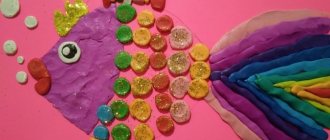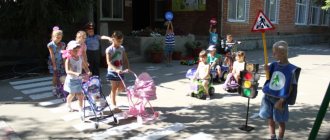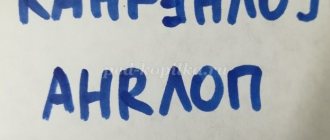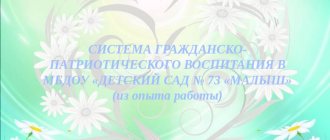Journey into the past books
SUMMARY OF THE OPEN CLASS
“JOURNEY TO THE PAST BOOKS”
PREPARATORY GROUP
Educator:
Bezrukikh I.V.
Smolensk 2021
“Journey to the past books” for children of the preparatory group
Purpose: familiarization with the history of the development of books and writing
.
Tasks:
• Introduce children
with the history of the origin of
the book
(knot books -
books-stones
,
books made of clay
,
books made of papyrus
,
books made of parchment
).
• Develop cognitive interest, the ability to draw conclusions, generalize, and reflect.
• Foster a caring attitude and interest in books
.
Materials: multimedia, laptop, presentation
.
Progress of the lesson:
Educator: - I want to tell you a riddle, and only by guessing it will you understand what subject we will talk about today.
I know everything, I teach everyone
And I myself am always silent
To make friends with me
You need to learn to read ( Book )
- What is it about?
Children: Book
Educator: That's right, guys, this is a book
.
Today, like real scientists, we will explore the book
.
This magic screen will help us cope with this task. SLIDE 2. Please take a closer look at this book
.
What does it consist of? What are the main parts? ( Children's )
correct, here is the spine, binding, sheets, cover.
Educator: Do you think the book always looked like this?
?
Children: No.
Educator: let's all take a short trip into the past of the book
. Do you agree?
Children: Yes.
Educator: In distant, distant times, when paper had not yet been invented and there was no written language, people came up with different ways to transmit information. One of these methods was writing in pictures. For example, they will draw a lake and a huge fish nearby - this means the memory of a successful fish catch. And if there are a lot of bags, it means that the person has reaped a good harvest. SLIDE 3. Let us now try to guess what this ancient drawing is telling us. SLIDE 4. But since there was no paper in those days, people depicted all these events on stone slabs. Such slabs could be stored for a very long time. Later, the drawings were slightly modified, simplified, and gradually turned into signs that began to be called hieroglyphs, denoting individual words and even entire sentences. There were entire libraries of such stone tiles.
Now imagine that you have such stone books
. It's comfortable?
Children: No, they are heavy, take up a lot of space, and are difficult to pick up.
SLIDE 5. Educator: Later books
began to be made from clay.
Signs and pictures were squeezed out on soft clay with a sharp stick. Then the clay was dried and fired in ovens. The resulting clay tablets were very durable. Each book
consisted of several dozen and even hundreds of tiles, just like our
book of many pages
.
Do you think it was convenient to read and store books
written on clay tablets?
And why? (no, clay can collapse, you need a lot of space to store it)
SLIDE 6. Educator: then people began to use other materials. They wrote with a pointed stick on palm leaves, SLIDE 7. and in Rus' they used birch bark for this. Do you know what birch bark is? ( children's )
.
Would you like to try scratching something on birch bark yourself? (Suggest trying to scratch something on birch bark)
. But this material was not convenient and practical to use, since it could not be stored for a long time.
SLIDE 8. Later, people began to make books from papyrus
.
Papyrus is a plant twice the height of a human. Its trunk is as thick as your hand. It grows in Africa along the banks of rivers and lakes. The core of such a reed was cut into strips, they were laid on top of each other, pressed down with weight, and dried in the sun. The result was sheets on which one could write. Then the sheets were glued together into a long, very long scroll. Thus, books appeared - scrolls
, similar to a wide and long ribbon in which there are no pages.
SLIDE 9. Educator: But papyrus did not grow everywhere. And where it was not, people learned to write on parchment. What is it? This is the skin of young animals, which was carefully cleaned, scraped, polished until it turned yellow or white. Several sheets of parchment made up a book
.
Years and centuries passed, and gradually they forgot about papyrus and parchment. Because paper appeared. White, smooth, comfortable. And they came up with the idea of making it in ancient China.
SLIDE 10, 11. Educator: Books
They were written by hand with a quill pen and ink, by specially trained people with beautiful handwriting.
They were called chroniclers. The book
then decorated with precious stones, gold or silver.
It was certainly beautiful, but only rich people could afford such a book
.
one book
, up to several months, and sometimes even more than one year. It was very hard work.
SLIDE 12. Ability to create books
appeared faster and easier when people invented the printing press.
From then on, it was no longer necessary to write down every letter.
Ivan Fedorov
founded book printing He went down in history as the first printer. How did he do this? He made letters from which he later composed words. I smeared the letters with paint, applied them to the paper and the text was imprinted on it. It was much faster than writing by hand. Let's check this now. (invite children to the table
, hand out blank sheets and stamps)
SLIDE 13. Over time, the method of making a book
It has improved more and more and now even a computer is used to make
books
.
There are a lot of books now
, they are very different and accessible to everyone.
What do you think books
?
Children: to read, know a lot, become smarter, learn new things, do well in school.
SLIDE 14. Educator: That's right, well done! Books
needed to transfer knowledge.
Where are all the books
?
(Library)
Summing up:
— What new did you learn in class today? How did the book
?
Summary of a lesson on the world around us “Journey into the past of books”
Summary of a lesson on the world around us in the preparatory group
“Journey to the Book’s Past.”
Program content:
— Introduce children to the history of the origin and production of the book.
— To give children knowledge of how the book was transformed under the influence of human creativity, while maintaining essential characteristics.
— To arouse interest in human creative activity.
— Cultivate a caring attitude towards books.
Material for the lesson:
Illustrations depicting old books; knotted writing, birch bark, Egyptian papyrus, rock painting.
Illustrations of the stages of making a book, an image of a printing press. Exhibition of various books.
Illustrations with ancient capital letters drawn on leaves.
Progress of the lesson.
Children, now I’ll tell you a riddle, and you think and tell me, what is it?
She speaks silently
But it’s understandable and not boring
You talk to her more often -
You will be four times smarter!
(Book).
That's right, it's a book.
What are books for? (Listen to the children's answers). To read, to learn new things, to study at school, to be smarter. That's right, people pass on knowledge and information to each other through books.
Draw children's attention to an exhibition of modern books.
— Tell me, what kind of books are there? (dictionaries, encyclopedias, books for adults and children).
—What are books made of? (from paper).
— What parts does the book consist of? (cover, spine, pages).
—Have books always been what you think? (Not always).
-Right. Once upon a time there was a time when there were no books. The only means of preserving and transmitting information about events and people was human memory. The necessary information was memorized and “live letters” - messengers - were sent over long distances. But it was difficult to remember a lot, and then people came up with the idea of tying knots on a long rope or ribbon, then tangling it into a ball. (Show illustration). To read such a “rope letter”, you had to unfold it and run your fingers along all the knots. You can imagine how inconvenient such “rope letters” were. The knots could break, get tangled, and the knot words could be forgotten.
Then, people invented picture writing. (Show illustration). The person depicted some action in the drawing. The author could easily talk about what he drew. You can also compose such a picture message on any topic. Draw, for example, how you went for a walk with friends or parents, what happened during the walk, and what happened afterwards.
But the trouble is, not everything can be conveyed in such a drawing. One may understand it in his own way, another may understand it differently.
Gradually, people looked for new ways to convey thoughts. The man had already invented letters and knew how to write. He wrote down what he wanted to remember. What did he write on? Scientists find inscriptions on stones and rocks. (Show illustration). They are stored for thousands of years. It's comfortable? (Children's answers).
In different countries they wrote on the material that was around. For example, on clay tablets. (Show illustration). They wrote on a damp clay tablet with a sharp stick.
— Do you think it was convenient to read such books? (Children's answers). No, it's inconvenient. They are heavy and awkward to flip through.
People have also tried to write on birch bark. (Show illustration). Birch bark is the outer part of birch bark. Letters were scratched with special bone tools. However, this method of writing was also inconvenient.
But in Ancient Egypt they wrote on papyrus. This is a marsh plant that looks like a reed. Its smooth stems were cut lengthwise and laid in rows, then pressed. The result was a material similar to paper, only thinner. Large texts were written with pointed sticks on long strips of papyrus. Their length sometimes reached up to 40 meters, then they were rolled into scrolls. (Show illustration). Unfortunately, papyrus is not very durable. He only needs dry air. Therefore, the man was looking for new material for writing. It became parchment. Parchment is processed leather made from calf hides. It was stronger. For the first time, books began to be made from parchment, very similar to ours. They were very expensive, because one book required a whole herd of cows! It is clear that only a rich person could buy the book.
The paper helped the man. It was invented in China. The Chinese kept the secret of making paper a secret from other nations for a long time. And only centuries later they learned how to perform this miracle. And then the first books made of paper appeared. At first they were written by hand with a pen. Usually it was written by a person who had beautiful handwriting. (Show illustration of the chronicler).
To make the book attract attention, it was beautifully designed: pictures were drawn, capital letters were highlighted with bright colors. (Show an illustration of an old book and ancient capital letters drawn on the sheets).
It took a lot of time to write one book by hand.
— Do you think these books were accessible to many people?
— What did people come up with so that there were a lot of books? (They came up with the idea of printing).
Man invented the printing press. (Show printing press). And he speeded up the production of books. The machines cut and stitch the pages, print colorful covers and illustrations, and make the binding so that the book lasts longer.
— What do you think needs to be prepared before publishing a book? (Children's answers). Material for the book. Poets, writers, and artists are working on this. They decide what size the book will be, what it will look like, what the drawings will be.
— What professions do people work on creating a book? (writers, artists, printers, typesetters). Smart machines unwind paper from the drum, cut it, print it, chop the sheets into separate notebooks, stitch them and make binding. This is how long and difficult the journey of the book is and how many people take part in its creation.
And so the writer Leo Tolstoy tells a fairy tale. Even though the machine has no mind, But it knows business. She will cut the sheets for you herself and fold them skillfully. And the bookbinder will sew them together, trim the edges instantly, then put them in binding, and here is the book in front of you. It's nice to read books, but try to make them. Printing is a subtle art, and requires study.
teacher: - Children, how many of you know what rules must be followed so that our eyes do not get tired while reading? That's right, don't bend low, the light should fall from the left side, don't read lying down or while moving in public transport.
And now we will learn gymnastics for the eyes. Gymnastics for the eyes: We read, drew, Our eyes are so tired, Let's stand together in order, Let's do exercises for the eyes. We do eye exercises every time. Right, left, around, down, Don’t be lazy to repeat. Strengthening the eye muscles. We'll see better right away. (invite the children to follow with their eyes the movement of an object moving in different directions.) Educator: Do you know how to take care of books?
Lesson summary:
This is how long the book has come until it became what we know it now. The man was constantly thinking, thinking, carefully studying what surrounded him. Nowadays paper is made from wood. It remains the main material for writing and printing to this day.



